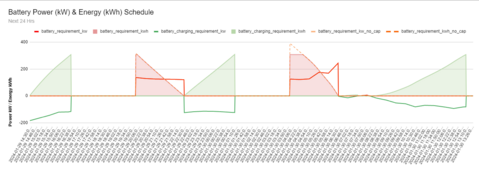mikaelmaingard
New Member
I am trying to build an optimization mechanism for a theoretical hybrid plant (pv+battery+inverter). The main idea is to 1) compute an optimal schedule for battery charge/discharge considering the environmental forecasts [pv, load, and loadshedding (grid on/off)], and then 2) program the inverter such that it charges and discharges the battery according to the schedule from step 1.
I am happy with step 1 (see the attached example battery schedule), but I am stuck on step 2 and would love some direction from the community. What would I need to communicate to a typical inverter (e.g., Deye/Sunsynk) for it to be able to control a battery according to a schedule?
I have two main ideas:
1) Program the inverter ahead of time with the scheduled charge/discharge times such that it charges the battery when scheduled to charge and discharges the battery when scheduled to discharge.
Or, 2) Implement an external control system that communicates with the inverter to set (on-the-fly) the battery charge/discharge rate such that the battery SOC tracks the scheduled SOC.
Feel free to call out any naivety on my part, but please couple it with some sound wisdom. Thanks!

I am happy with step 1 (see the attached example battery schedule), but I am stuck on step 2 and would love some direction from the community. What would I need to communicate to a typical inverter (e.g., Deye/Sunsynk) for it to be able to control a battery according to a schedule?
I have two main ideas:
1) Program the inverter ahead of time with the scheduled charge/discharge times such that it charges the battery when scheduled to charge and discharges the battery when scheduled to discharge.
Or, 2) Implement an external control system that communicates with the inverter to set (on-the-fly) the battery charge/discharge rate such that the battery SOC tracks the scheduled SOC.
Feel free to call out any naivety on my part, but please couple it with some sound wisdom. Thanks!




